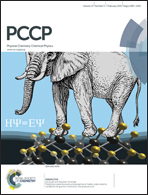Fluoride ion sensing in aqueous medium by employing nitrobenzoxadiazole-postgrafted mesoporous silica nanoparticles (MCM-41)†
Abstract
A mesoporous silica-based inorganic–organic hybrid material (NBD–AP–MCM) has been designed and developed as a fluorescent chemosensor for the detection of fluoride in aqueous medium. The system was developed by covalently anchoring 7-nitro-2,1,3-benzoxadiazole (NBD) dye onto the surface of mesoporous silica nanoparticles, MCM-41. The system was characterized using several conventional analytical methods comprising spectroscopic, microscopic and thermo-gravimetric techniques. The sensory action of the material was investigated by carrying out steady state absorbance, fluorescence and time resolved fluorescence studies on the system in the absence and presence of several biologically and environmentally important anions in aqueous solution. The photophysical data of the present system (NBD–AP–MCM) have also been compared with the free dye (NBD) molecules. A significant decrease in the fluorescence quantum yield of the fluorophore in the hybrid material NBD–AP–MCM has been observed as compared to the unbound NBD. The decrease in fluorescence efficiency in the hybrid material is attributed to the aggregation caused quenching (ACQ) phenomenon. Interestingly, the system displays more than six-fold fluorescence enhancement in the presence of fluoride ions in aqueous solution. Enhancement of the fluorescence lifetime of the fluorescing moiety (NBD) has also been observed during fluorescence time-resolved studies. No significant optical changes have been observed with other commonly encountered anions rendering the present system highly selective towards fluoride detection. The fluorescence enhancement has been attributed to the cleavage of Si–O bonds due to the addition of fluoride. The silyl cleavage detaches the fluorophore from the solid support thereby making the fluorophore “free” in solution, which in turn recovers its original fluorescence which was decreased because of the aggregation on the solid silica support. Furthermore, the suitability of the present system in cellular imaging has also been demonstrated.


 Please wait while we load your content...
Please wait while we load your content...